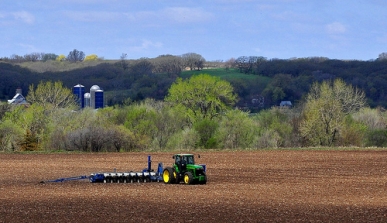If the weather is a roller coaster, farmers are riding up front
Everyone talks about the weather, but for most of us it’s just conversational chitchat. That’s not the case for farmers or those who work with them. For those folks, yesterday’s rain or last week’s temperatures mean a lot more than whether the grass is green or the kids’ soccer games were washed out. Weather, for them, can be the difference between a bumper crop or a bust, between profit and loss.
Unfortunately, dealing with weather variability is getting harder for farming and agriculture. Mother Nature has taken to extremes in recent years, and this year is turning out to be a whopper. This spring, we saw ongoing severe drought in some places and torrential rains not far away. Just last year, it was so warm and dry farmers were pretty much done planting in April. This year, it was so cold and then so wet in many areas that less than 20% of seed was in the ground by the middle of May.
It’s not just one year to the next that is a rollercoaster. Already this spring there’s been wild variability over a span of days or months, and from one side of a state to the other:
- Western Iowa is still in severe drought, but the eastern part of the state has gotten so much rain that the rivers are flooding and crop fields are nothing but massive puddles that can’t be planted.
- After a very cold spring, mid-May brought a phenomenal surge of heat to the central Plains and western Corn Belt, sending temperatures to record highs for the month. For example, after a late freeze on May 12, temperatures hit 108°F on May 14 in Tekamah, NE, breaking a record for the month set back in 1934 – the days of the Dust Bowl. Tekamah was not alone; in Iowa, Sioux City (106°F) and Sac City (108°F) broke Dust Bowl-era records; so did Grand Island (102°F) and Omaha (101°F) in Nebraska.
- Parts of the Great Plains and Corn Belt are still suffering severe drought, with every Great Plains state except North Dakota seeing poor to very poor conditions in at least one-third of its rangeland and pasture. But move east a bit to Rochester, MN, and May set a precipitation record with 8.55 inches of rain, after almost 10 inches in March and April.
These wild weather swings imperil the livelihood of thousands of farmers and their families, as well as communities and businesses. What’s more, those farmers and the corn, wheat, soybeans and other crops they grow are the foundation of our food system in terms of sales, acreage, and volume.
What this wild weather ride drives home for me is that resilience is the key to survival. And that comes down to implementing practices that give crops the best chance to thrive, whether it’s wet or dry, warmer or colder. EDF is working to promote practices that help farmers deliver both the productivity our food system needs and the ecosystem benefits, like clean water, we all need. We’re helping famers:
- Use better information to manage nutrients more efficiently. The more information they have, the better farmers can manage their nutrients, in particular costly fertilizers. Apply too much and the excess (along with the money that paid for it) gets washed into rivers and lakes. Apply too little or at the wrong time, and yields suffer. EDF is working to increase awareness of and access to innovative tools and methods that help farmers measure more precisely the nutrient needs and status of their crops.
- Plant cover crops and adopt reduced tillage practices. Cover crops and reducing tillage increase the vegetation holding the soil in place and make the soil healthier, enabling it to hold moisture better, prevent soil erosion, and increase the productivity of the soil itself. So if it rains really hard, cover crops and no till prevent those rains from washing soil away. And if the rains just don’t come, these same practices hold on to what moisture there is in the soil, helping it support a crop more than tilled soils.
- Implement strategically placed buffers and wetlands. These practices can slow down flood waters, reducing how much damage they do by rushing across farm fields. They can also store water in drier times, allowing that water to feed back slowly into fields. And they can moderate the level of the water in the soil itself. Done right, these practices can dramatically improve water quality and the resiliency of a landscape without taking much land out of production.
These days, thanks at least in part to global warming, Mother Nature has farmers on a wild rollercoaster ride. They need the tools to adapt so they can provide all of us with food on the table and a cleaner, healthier environment.












